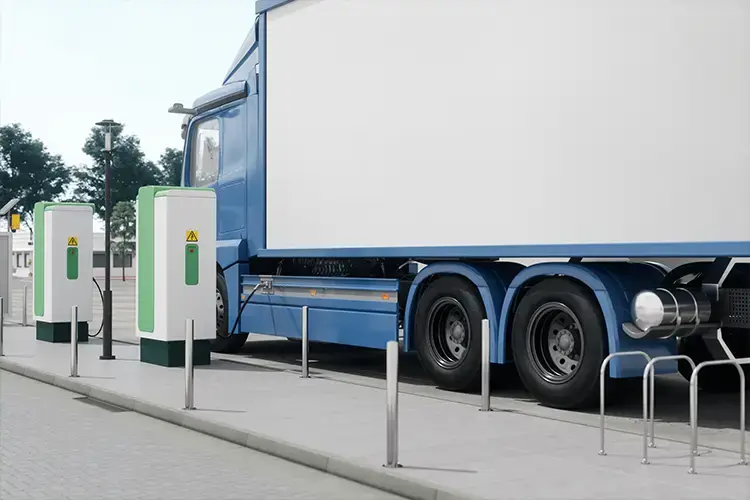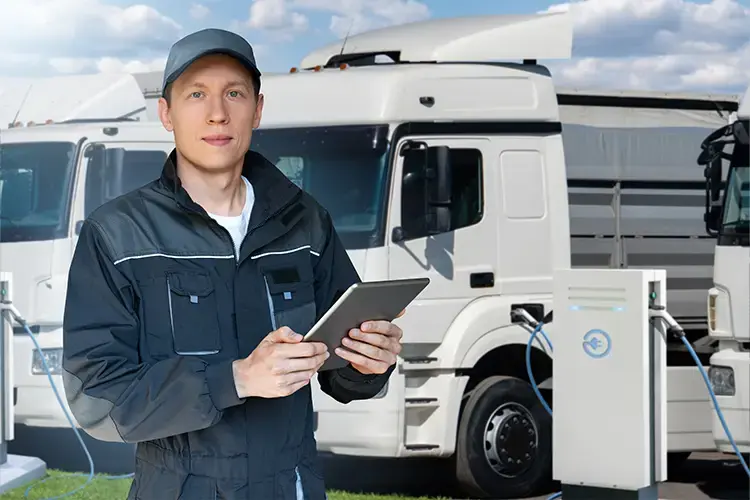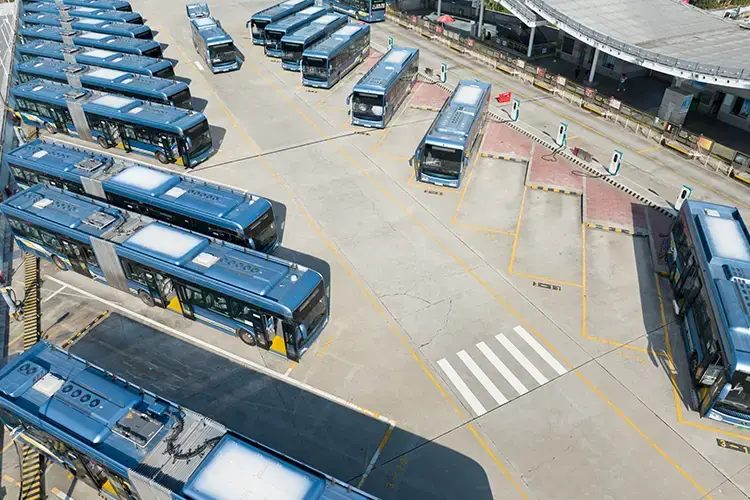Electric truck charging – electrifying Europe's roads
Inhaltsverzeichnis
Key facts at a glance
- Electric trucks in Europe can benefit from public, depot, and destination charging, each serving different operational needs and integrating into the broader transport infrastructure.
- Expanding the charging network offers significant benefits for fleet managers, including lower energy costs compared to diesel, increased operational flexibility, and reduced downtime.
- UTA eCharge Service offers seamless access to over {$E-charge stations europe} public charging points across Europe, integrating charging solutions with fuel card services to streamline the management and costs of electric fleet operations.
In the rapidly evolving landscape of European transport, the transition to electrification has become a strategic imperative to meet the EU's ambitious 2030 climate targets. Recognising the central role of infrastructure in this transition, the European Commission presented an action plan in November 2023 outlining the need for nearly 600 billion euro of investment in electric truck charging infrastructure.1
Electric trucks are at the forefront of this transformation, offering a promising solution to reduce carbon emissions and improve the sustainability of freight transport. This article examines the three primary charging methods for electric trucks: public charging, depot charging and destination charging. It provides an overview of the current status of each type and their central role in the integration of electric trucks into the European transport network.

TOC - Inhaltsverzeichnis @ TRIALTA - Hier benötigen wir ein TOC Modul
- Thema 1
- Thema 2
- Thema 3
- Thema 4
Public charging
Public charging stations for electric trucks can be found all over Europe. They are usually located in strategic places such as motorway service stations or large car parks. There are two main types of public charging stations: fast charging and overnight charging.
- Public fast charging stations are designed to charge electric vehicles (EV) quickly, usually during a driver's break. The average charging time is around 0.5 to 1 hour, with DC chargers ranging in power from 500 kW to over 1 MW. This type of EV fast charging is particularly suitable for long journeys where drivers use their mandatory breaks to recharge.
- Public overnight charging usually happens in public places where drivers take longer breaks, e.g. overnight. The chargers used for overnight charging offer lower power (between 100 kW and 150 kW DC) and are designed to fully charge the vehicle over a longer period of up to 9 hours. This method is particularly relevant for long distance journeys where electric trucks are parked overnight.
Benefits of public charging for the transport industry
The continued expansion of the public charging network for electric trucks offers economic and operational benefits to fleet managers while supporting environmental initiatives:
- Increased operational flexibility: A robust network of public charging points allows greater flexibility. Trucks can be deployed without having to return to a specific location to recharge. This shortens delivery times and simplifies route planning.
- Longer distances possible: More public charging stations mean that fleet managers can plan longer routes without fear of running out of battery power, increasing the reliability of electric trucks in long-haul transport.
- Lower energy costs: Public charging stations, especially those with fast charging capabilities, can offer electricity at competitive prices compared to diesel fuel, resulting in substantial energy cost savings.
- Improved fleet efficiency: Access to a nationwide charging network enables continuous operation of electric trucks. Fleet managers can schedule charging during drivers' mandatory rest periods, minimising downtime.
- Greater sustainability: Using electric trucks and a public charging infrastructure reduces the carbon footprint and helps protect the environment.
Availability of public charging stations
According to the European Alternative Fuels Observatory (EAFO), significant progress has been made across the European Union. From the beginning of 2020 to the beginning of 2024, the number of public AC charging stations in the EU increased from over 120,000 to almost 600,000. Over the same period, the number of DC charging stations increased from over 6,000 to more than 90,000.2
Simultaneously, Milence, an independent joint venture founded in 2022 by the Traton Group, the Volvo Group and Daimler Trucks, is driving this progress. With an investment of 500 million euros, Milence aims to build and operate more than 1,700 fast (300 to 350 kW) and ultra-fast (1 MW) charging stations across Europe by 2027. These facilities will cater to heavy duty electric vehicles, among others, and will make a significant contribution to bolstering the electric truck charging infrastructure.3

underwent a remarkable transformation, with numbers soaring from just over 120,000 to nearly 600,000.
Depot charging
Depot charging entails installing electric vehicle charging facilities at a company's primary operating base, commonly known as a truck or home depot. This is where vehicles typically return at the end of their shifts, making it ideal for charging. It's particularly important for short-haul and, to a lesser extent, medium-haul trucks, which can be charged overnight during regular and extended downtime. Charging typically takes around 8 hours (overnight), with chargers ranging from AC 22kW to DC 150kW. Depending on the specific needs of the fleet, such as driving patterns, battery capacity and actual depot time, the power output and current settings of the chargers can vary to optimise charging times and vehicle availability.
Advantages of charging e-trucks at the depot
Charging electric trucks at the depot is a structured and efficient solution for transport companies switching to electric fleets. This centralised charging strategy not only streamlines operations, but also supports environmental and economic goals. Here are some of the key benefits:
- Cost efficiency: Charging vehicles overnight during off-peak hours significantly reduces the energy costs associated with operating an electric fleet. This leads to significant savings over time. Depot charging is also less expensive than public charging, as the tariffs are better. If the company has solar panels, the electricity costs are minimised.
- Improved fleet management: Depot charging centralises the charging process, allowing fleet managers to efficiently oversee fleet operational readiness and monitor energy consumption. This centralised approach simplifies management and enhances efficiency.
- Less downtime: Vehicles can be charged during idle times, such as overnight. This scheduling minimises service interruptions and ensures that vehicles are fully charged and ready for use during business hours. Nevertheless, scheduling can be challenging for fleet managers as there are many factors to consider. But software is available to help plan driving and refuelling schedules for e-trucks.
- Investment in infrastructure: Investing in depot charging infrastructure, including solar panels, proves beneficial in the long term as it supports the sustainable operation of an electric fleet, aids in achieving sustainability goals, and has the potential to enhance property value.
- Increased security: Charging at the depot site can bolster security by ensuring both the physical safety of the vehicles and the integrity of the charging process.
- Reduced environmental impact: Utilising depot charging helps in reducing the carbon footprint of fleet operations. By switching to electric vehicles and managing them efficiently, companies can significantly lower their emissions and contribute to environmental sustainability.
- Scalability and adaptability: Depot charging stations are designed to be scalable, allowing companies to expand their charging capabilities as their fleet grows. This flexibility supports the gradual transition from conventional to electric vehicles without substantial disruptions.
Status of depot charging in the EU
Depot charging is expected to be an important solution for trucks travelling within their own country. It is predicted that this type of charging will account for 45 per cent of the charging demand for trucks on long-distance journeys and 65 per cent for shorter, regional journeys.
McKinsey emphasises in an article from 2020 that the total cost of ownership for overnight charging at depots is significantly lower compared to alternative charging solutions.4 This suggests that in future an increasing number of companies will rely on depot charging.

needs for trucks embarking on extensive travels and 65 percent for those on brief, regional trips.
Destination charging
Destination charging refers to the process of charging electric trucks while they are being loaded or unloaded at their delivery destinations, such as stores or logistics centres. This method efficiently utilises the typical one to two hours required for loading and unloading operations to recharge the vehicle's battery. Equipped with DC chargers that deliver up to 350 kW, destination charging stations can significantly replenish a truck’s battery in this short window, ensuring the vehicle is ready for continued operation without requiring additional downtime solely for charging. This charging setup is ideal for maintaining the operational flow while integrating the necessary recharging into the natural pauses in a truck's journey.
Advantages of destination charging
Destination charging offers significant advantages for electric truck operations, especially for drivers who need to cover longer distances or have a higher daily mileage than their truck's battery capacity can initially support. This charging strategy involves rapid recharging at the customer's premises during routine stops for loading and unloading. One of the key benefits for operators is the ability to increase the range of electric trucks while investing in smaller batteries, which can significantly reduce initial costs.
This fast and efficient charging method not only increases operational flexibility, but also ensures that trucks can be quickly recharged during short stops, minimising downtime. Combined with overnight charging, destination charging provides a comprehensive solution that supports longer distances and more intensive use cases, making electric trucks attractive for a wider range of transport activities.
Status of destination charging in the EU
Charging at the destination offers considerable advantages, but also requires companies to invest in charging stations. In addition, fast charging puts more stress on the battery than overnight charging. Therefore, this strategy can lead to poorer battery performance over time than depot charging and is also more expensive.
Unlike plug-in charging, which utilises an industry-standard cable connected from the charger to the truck, pantograph charging eliminates the need for cables by employing specially designed overhead infrastructure. Pantograph charging involves an extendable arm, known as a pantograph, mounted on top of the vehicle. This setup allows electric trucks and buses to charge more efficiently during regular operation by quickly and automatically connecting to compatible charging hardware.
While the initial setup for pantograph charging is more expensive due to its custom hardware requirements, it is expected to play a crucial role in the future of long-haul electric trucking. This is because it facilitates 'opportunity charging' pit stops along routes and enables convenient overnight depot charging. Pantograph charging can deliver up to 600kWh, significantly higher than the approximately 300kWh provided by DC plug-in charging. This capacity can extend the vehicle's range by 100 miles in just 10 to 15 minutes.
Put the power of electric fleet management to work with UTA eCharge®
UTA Edenred offers a convenient solution for charging electric vehicles with UTA eCharge. This service provides seamless access to a vast network of charging stations across Europe and can be booked as an additional option to your fuel cards for companies. The UTA eCard card grants access to over {$E-charge stations europe} public charging points in 28 countries, allowing for easy and efficient charging.
Here you will find charging stations with outputs from 3.7 to 400 kW. This comprehensive coverage ensures that charging an electric vehicle is easy and hassle-free, no matter where you are. Companies can anticipate transparent and favourable prices due to the UTA Edenred standard tariff. The service is designed to maximise convenience, flexibility and cost-efficiency, making it the ideal choice for companies that want to manage their fleet's charging needs efficiently.
UTA Edenred also offers access to a comprehensive charging network in Europe with the Mercedes ServiceCard. Drivers can use it to charge their e-trucks at charging stations with outputs of up to 400 kW and more. Find out more here.

public charging points in 28 countries, enabling easy and efficient charging.
Sources:
[1]: https://milence.com/press-release/milence-publishes-white-paper-with-6-policy-recommendations-to-future-proof-europes-grid-for-electric-heavy-duty-vehicles/
[2]: https://alternative-fuels-observatory.ec.europa.eu/transport-mode/road/european-union-eu27/infrastructure
[3]: https://milence.com/press-release/milence-accelerates-europes-shift/
[4]: https://www.mckinsey.com/industries/automotive-and-assembly/our-insights/why-most-etrucks-will-choose-overnight-charging
